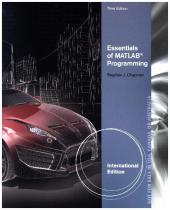 Neuerscheinungen 2017Stand: 2020-02-01 |
Schnellsuche
ISBN/Stichwort/Autor
|
Herderstraße 10
10625 Berlin
Tel.: 030 315 714 16
Fax 030 315 714 14
info@buchspektrum.de |

Stephen J. Chapman
Essentials of MATLAB Programming
International Student Edition
3rd ed,. 2017. 512 p. w. ill. 232 mm
Verlag/Jahr: CENGAGE LEARNING EMEA; CL ENGINEERING 2017
ISBN: 1-305-97071-3 (1305970713)
Neue ISBN: 978-1-305-97071-7 (9781305970717)
Preis und Lieferzeit: Bitte klicken
Now you can master the MATLAB language as you learn how to use it effectively to solve typical problems with ESSENTIALS OF MATLAB© PROGRAMMING, 3E. Author Stephen Chapman emphasizes problem-solving skills throughout this book as he teaches MATLAB as a technical programming language. This edition clearly shows you how to write clean, efficient and well-documented programs, while simultaneously introducing you to many of the practical functions of MATLAB. The first seven chapters offer an ideal introduction to programming and problem solving with MATLAB. The last two chapters address more advanced topics of additional data types and plot types, cell arrays, structures, and new MATLAB handle graphics to give you the skills you need.
1. INTRODUCTION TO MATLAB.
The Advantages of MATLAB. Disadvantages of MATLAB. The MATLAB Environment. Using MATLAB as a Calculator. Summary. Exercises.
2. MATLAB BASICS.
Variables and Arrays. Creating and Initializing Variables in MATLAB. Multidimensional Arrays. Subarrays. Special Values. Displaying Output Data. Data Files.
Scalar and Array Operations. Hierarchy of Operations. Built-in MATLAB Functions. Introduction to Plotting. Examples. Debugging MATLAB Programs. Summary. Exercises.
3. TWO-DIMENSIONAL PLOTS.
Additional Plotting Features for Two-Dimensional Plots. Polar Plots. Annotating and Saving Plots. Additional Types of Two-Dimensional Plots. Using the plot function with Two-Dimensional Arrays. Summary. Exercises.
4. BRANCHING STATEMENTS AND PROGRAM DESIGN.
Introduction to Top-Down Design Techniques. Use of Pseudocode. The Logical Data Type. Branches. More on Debugging MATLAB Programs. Summary. Exercises.
5. LOOPS AND VECTORIZATION.
The while Loop. The for Loop Logical Arrays and Vectorization. The MATLAB Profiler. Additional Examples. The textread Function. Summary. Exercises.
6. BASIC USER-DEFINED FUNCTIONS.
Introduction to MATLAB Functions. Variable Passing in MATLAB: The Pass-By-Value Scheme. Optional Arguments. Sharing Data Using Global Memory. Preserving Data Between Calls to a Function. Built-in MATLAB Functions: Sorting Functions. Built-in MATLAB Functions: Random Number Functions. Summary. Exercises.
7. ADVANCED FEATURES OF USER-DEFINED FUNCTIONS.
Function Functions. Local Functions, Private Functions, and Nested Functions. Function Handles. Anonymous Functions. Recursive Functions. Plotting Functions. Histograms. Summary. Exercises.
8. ADDITIONAL DATA TYPES AND PLOT TYPES.
Complex Data. Strings and String Functions. Multidimensional Arrays. Three-Dimensional Plots. Summary. Exercises.
9. CELL ARRAYS, STRUCTURES, AND HANDLE GRAPHICS.
Cell Arrays. Structure Arrays. Handle Graphics. Position and Units. Printer Positions. Default and Factory Properties. Graphics Object Properties. Summary. Exercises.
Appendix A: UTF-8 Character Set.
Appendix B: MATLAB Input / Output Functions.
Appendix C: Answers to Quizzes.


